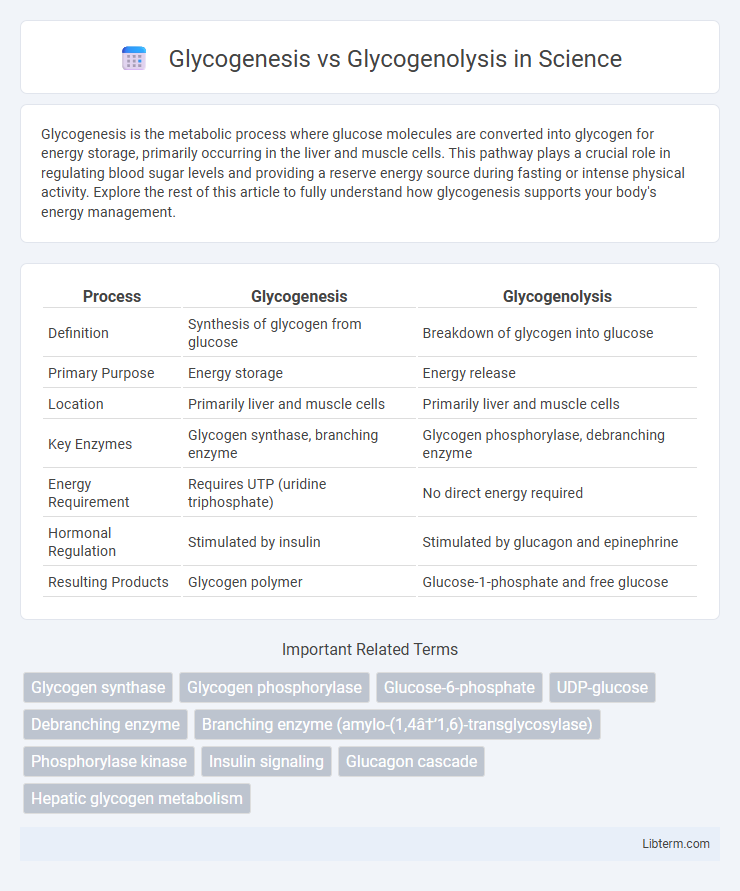Glycogenesis is the metabolic process where glucose molecules are converted into glycogen for energy storage, primarily occurring in the liver and muscle cells. This pathway plays a crucial role in regulating blood sugar levels and providing a reserve energy source during fasting or intense physical activity. Explore the rest of this article to fully understand how glycogenesis supports your body's energy management.
Table of Comparison
| Process | Glycogenesis | Glycogenolysis |
|---|---|---|
| Definition | Synthesis of glycogen from glucose | Breakdown of glycogen into glucose |
| Primary Purpose | Energy storage | Energy release |
| Location | Primarily liver and muscle cells | Primarily liver and muscle cells |
| Key Enzymes | Glycogen synthase, branching enzyme | Glycogen phosphorylase, debranching enzyme |
| Energy Requirement | Requires UTP (uridine triphosphate) | No direct energy required |
| Hormonal Regulation | Stimulated by insulin | Stimulated by glucagon and epinephrine |
| Resulting Products | Glycogen polymer | Glucose-1-phosphate and free glucose |
Introduction to Glycogenesis and Glycogenolysis
Glycogenesis is the biochemical process by which glucose molecules are polymerized to form glycogen, primarily occurring in the liver and muscle cells to store excess glucose. Glycogenolysis involves the enzymatic breakdown of glycogen into glucose-1-phosphate, facilitating the release of glucose during energy demand or fasting conditions. These opposing pathways regulate glucose homeostasis by balancing glycogen synthesis and degradation according to the body's metabolic needs.
Definition and Overview of Glycogenesis
Glycogenesis is the metabolic process of synthesizing glycogen from glucose molecules, primarily occurring in liver and muscle cells for energy storage. It involves the conversion of glucose-6-phosphate to glycogen through a series of enzymatic reactions, with glycogen synthase as the key regulatory enzyme. In contrast, glycogenolysis is the breakdown of glycogen into glucose-1-phosphate to provide energy during fasting or increased physical activity.
Definition and Overview of Glycogenolysis
Glycogenolysis is the biochemical process that breaks down glycogen into glucose-1-phosphate, providing a rapid source of glucose for energy production, especially during fasting or intense physical activity. This catabolic pathway involves key enzymes such as glycogen phosphorylase and debranching enzyme, which facilitate the mobilization of stored glycogen in liver and muscle tissues. In contrast, glycogenesis is the anabolic process that synthesizes glycogen from glucose, serving as a storage mechanism to regulate blood sugar levels and energy reserves.
Key Steps in Glycogenesis Pathway
Glycogenesis involves the conversion of glucose to glycogen through key steps including the phosphorylation of glucose to glucose-6-phosphate by hexokinase or glucokinase, isomerization to glucose-1-phosphate, and activation to UDP-glucose via UDP-glucose pyrophosphorylase. Glycogen synthase then catalyzes the addition of UDP-glucose to a growing glycogen chain, forming a-1,4-glycosidic bonds, while the branching enzyme introduces a-1,6-glycosidic branches for structural complexity. This pathway is regulated by insulin and allosteric effectors to promote energy storage during periods of glucose abundance.
Key Steps in Glycogenolysis Pathway
Glycogenolysis involves the breakdown of glycogen into glucose-1-phosphate primarily through the enzymatic action of glycogen phosphorylase, which cleaves a-1,4 glycosidic bonds. The second key step includes the debranching enzyme complex, which removes a-1,6 linked branches, allowing further glycogen phosphorylase activity. Glucose-1-phosphate is subsequently converted to glucose-6-phosphate by phosphoglucomutase, facilitating entry into glycolysis or glucose release via glucose-6-phosphatase in hepatic cells.
Enzymes Involved in Glycogenesis vs Glycogenolysis
Glycogenesis involves key enzymes such as glycogen synthase, which catalyzes the addition of glucose units from UDP-glucose to the growing glycogen chain, and branching enzyme, responsible for creating a-1,6-glycosidic branches. Glycogenolysis primarily relies on glycogen phosphorylase, which breaks a-1,4-glycosidic bonds to release glucose-1-phosphate, and debranching enzyme, which resolves a-1,6 branches to facilitate further glucose release. The regulation of these enzymes ensures a balance between glycogen synthesis and breakdown in response to cellular energy demands.
Regulation of Glycogenesis and Glycogenolysis
Regulation of glycogenesis and glycogenolysis is primarily controlled by hormonal signals such as insulin, glucagon, and epinephrine, which modulate enzyme activity to maintain blood glucose homeostasis. Insulin promotes glycogenesis by activating glycogen synthase through dephosphorylation, while glucagon and epinephrine stimulate glycogenolysis by activating phosphorylase kinase via phosphorylation, leading to glycogen breakdown. Key enzymes like glycogen synthase and glycogen phosphorylase are regulated allosterically and covalently to ensure precise and rapid response to metabolic demands.
Physiological Roles and Importance
Glycogenesis plays a crucial physiological role by converting glucose into glycogen for energy storage, primarily in liver and muscle cells, ensuring a readily available energy reserve during fasting or intense activity. Glycogenolysis, conversely, breaks down glycogen into glucose-1-phosphate, supplying glucose to maintain blood sugar levels and support cellular metabolism during periods of increased energy demand or between meals. Both processes are essential for metabolic homeostasis, preventing hypoglycemia and sustaining energy balance in various tissues.
Clinical Significance and Disorders
Glycogenesis, the process of glycogen synthesis, plays a crucial role in maintaining blood glucose levels, while glycogenolysis breaks down glycogen to release glucose during fasting or increased energy demand. Disorders such as Glycogen Storage Diseases (GSDs), including Von Gierke disease (GSD Type I) and McArdle disease (GSD Type V), result from enzyme deficiencies that disrupt these pathways, leading to hypoglycemia, muscle weakness, or hepatomegaly. Understanding the balance between glycogenesis and glycogenolysis is essential for diagnosing and managing metabolic conditions like diabetes mellitus and glycogen storage disorders.
Summary: Differences and Similarities
Glycogenesis is the metabolic process of synthesizing glycogen from glucose for energy storage, primarily occurring in the liver and muscle cells, whereas glycogenolysis involves the breakdown of glycogen into glucose-1-phosphate to provide energy during fasting or increased demand. Both processes are regulated by hormonal signals such as insulin promoting glycogenesis and glucagon and epinephrine stimulating glycogenolysis to maintain blood glucose homeostasis. Key enzymes involved include glycogen synthase for glycogenesis and glycogen phosphorylase for glycogenolysis, highlighting their complementary roles in energy balance.
Glycogenesis Infographic

 libterm.com
libterm.com